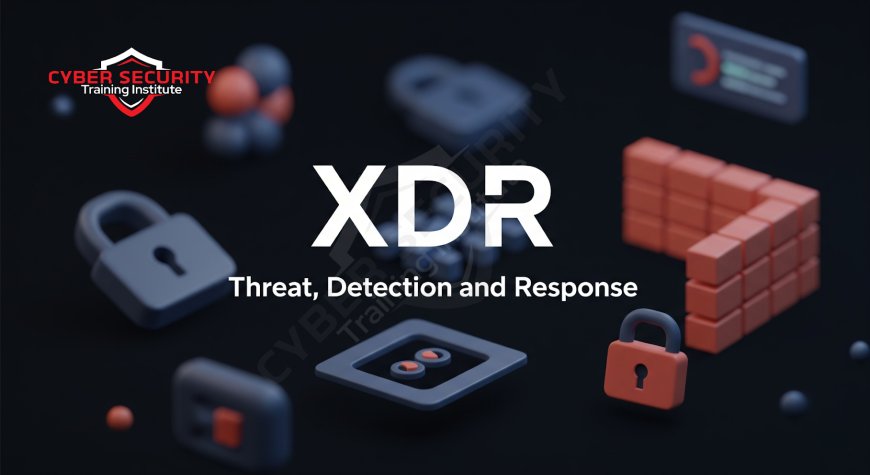What Is XDR? Exploring the Future of Threat Detection and Respons
Discover what XDR (Extended Detection and Response) is and how it revolutionizes threat detection with unified visibility, automated response, and reduced alert fatigue across endpoints, cloud, and networks.

Table of Content
- Introduction
- What Is XDR (Extended Detection and Response)?
- How XDR Works
- Benefits of XDR
- XDR vs. EDR vs. SIEM: A Comparison
- Core Features of XDR
- Why Organizations Are Shifting to XDR
- Conclusion
- FAQ
Introduction
As cyber threats become more advanced, traditional security solutions like SIEM and standalone EDR struggle to keep up. Enter XDR (Extended Detection and Response) — a unified approach designed to revolutionize threat detection and incident response by breaking down silos across various security layers. In this blog, we’ll explore what XDR is, how it works, its core benefits, and why it's a game-changer for modern cybersecurity.
What Is XDR (Extended Detection and Response)?
XDR (Extended Detection and Response) is a security solution that integrates data across multiple security layers — including endpoints, networks, servers, cloud workloads, and emails — to provide a centralized detection and response system. Unlike traditional tools that operate in isolation, XDR connects and correlates data to detect complex, multi-stage cyberattacks.
How XDR Works
XDR collects telemetry from various security components and applies advanced analytics, threat intelligence, and AI/ML models to detect and respond to threats across the entire infrastructure.
Key Functional Steps of XDR:
-
Data Collection from multiple vectors (endpoint, network, cloud, etc.)
-
Correlation and Analytics using AI and behavioral detection
-
Alert Prioritization by reducing false positives
-
Automated & Manual Response capabilities
-
Centralized Visibility through unified dashboards
Benefits of XDR
| Benefit | Description |
|---|---|
| Holistic View | Correlates threat data across various security domains |
| Improved Threat Detection | Detects advanced attacks that isolated tools may miss |
| Faster Incident Response | Automates responses, reducing Mean Time to Respond (MTTR) |
| Reduced Alert Fatigue | Aggregates and prioritizes alerts based on context |
| Streamlined Security Ops | Centralized management reduces complexity and workload |
XDR vs. EDR vs. SIEM: A Comparison
| Feature | XDR | EDR | SIEM |
|---|---|---|---|
| Coverage | Multi-layer (endpoint, cloud, etc.) | Endpoint-focused | Log-focused, customizable |
| Detection | Behavioral & correlated detection | Endpoint behavior | Rule-based |
| Response | Automated & manual | Mostly manual | Manual or limited automation |
| Alert Volume | Reduced via correlation | High | High |
| Complexity | Lower (managed approach) | Medium | High |
Core Features of XDR
🔹 Cross-Layer Detection
Unifies telemetry from various sources like endpoints, cloud, identity systems, and email.
🔹 AI-Powered Analytics
Uses machine learning and behavioral analysis to identify suspicious activity.
🔹 Automated Response
Triggers predefined response actions like isolating endpoints or disabling user accounts.
🔹 Threat Intelligence Integration
Feeds real-time threat intel into detection models for contextual decision-making.
🔹 Unified Security Dashboard
Security teams manage detection, alerts, and response from a centralized platform.
Why Organizations Are Shifting to XDR
-
Increased attack sophistication
-
Lack of skilled security professionals
-
Overwhelming alert volumes
-
Need for quicker response and lower TCO
XDR offers a modern, integrated alternative to legacy security stacks that were not designed to handle today’s complex threat environment.
Conclusion
XDR is the future of cybersecurity, offering a proactive, intelligent, and integrated defense against modern threats. By combining detection and response across multiple layers, XDR empowers security teams to react faster, reduce complexity, and stay ahead of cyber adversaries.
Whether you're a small organization or a large enterprise, adopting XDR could be the most strategic move you make in 2025 and beyond.
FAQ
What does XDR stand for?
XDR stands for Extended Detection and Response, a unified security solution for advanced threat detection across multiple domains.
How is XDR different from EDR?
While EDR focuses on endpoints, XDR extends beyond endpoints to include cloud, email, identity, and networks.
Does XDR replace SIEM?
Not entirely. XDR complements or enhances SIEM by offering better correlation, context, and automated response.
Can small businesses use XDR?
Yes. Managed XDR services are available for small to mid-sized businesses that lack large security teams.
Is XDR expensive?
XDR solutions can reduce costs over time by streamlining tools, reducing false alerts, and improving efficiency.
What vendors offer XDR platforms?
Popular XDR vendors include Palo Alto Networks, Microsoft, Trend Micro, CrowdStrike, and SentinelOne.
Is XDR a cloud-only solution?
No. XDR supports hybrid environments, including on-premises, cloud, and hybrid infrastructures.
What's Your Reaction?
 Like
0
Like
0
 Dislike
0
Dislike
0
 Love
0
Love
0
 Funny
0
Funny
0
 Angry
0
Angry
0
 Sad
0
Sad
0
 Wow
0
Wow
0















